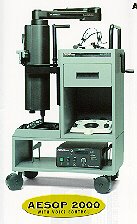
Robots utilized in medicine, especially in surgeries, serve as assistance to doctors in their role of dispensing medical treatment to patients and even enhance their services. An important aspect is the improvement of the surgeon’s dexterity during surgery. No matter how skilled a surgeon is, there is always a slight tremor of the hands. Morever, operations of highly sensitive and confined body spaces like the brain, heart and prostate, can be performed by only a limited number of surgeons who are skilled and experienced enough for the task. With the advent of such assistive robotic surgical systems as the Automated Endoscopic System for Optimal positioning (AESOP), the Da Vinci surgical system and the ZEUS robotic system, hand tremors are a thing of the past.
The robotic limbs, holding onto the surgical instruments, could execute movements that are as minute as a millionth of an inch. The march towards non-invasive surgery motivates the development of such systems. Increasing number of heart by-pass surgeries are now performed through pin-hole incisions, via a robot-assisted endoscopic extensions. The four-arm Da Vinci system offers great precision and eliminates the need for inverted manipulation of the surgical instruments as the on-board processor can translate the surgeon’s hand movements correctly into the desired manipulation of the surgical instruments. There is also three-dimensional imaging capability via a camera attached to one of the arms.
At the Medical Centre of Hershey, Dr Ralph J. Damiano Jr., used a surgical robotic system that has a camera that magnify views of operation procedures by a power of 16.
Voice commands-driven robots are also a possibility in another up-coming system, called “Hermes”. This will the advent of the “intelligent” operating theatre, in which the doctor just focus on making critical surgical decisions and “asks” the robot to execute the moves.

In use at 280 hospitals now is the AESOP system.
Using the Zeus or da Vinci system, largely invasive surgeries such as heart bypasses, can be made less painful and complicated. Traditional techniques of making a 1-foot-long incision on the chest and thereafter prying open the rib cage to reveal the heart is now replaced by cutting just a tiny hole of 1 cm through which endoscopic extensions containing fibre optics and surgical tools are inserted.
References:
How robotics will work, http://electronics.howstuffworks.com/robotic-surgery1.htm
Robotic Surgery, http://ipp.nasa.gov/innovation/Innovation52/robsurg.htm
Laproscopic Surgery, http://www.lapsurgery.com/robotics.htm#ROBOTS%20IN%20LAPAROSCOPIC%20INGUINAL%20HERNIA%20REPAIR
4 comments:
U0204997 Yeo Yunn En
I think its still along way before robot systems can replace human doctors in terms of surgery. If you interviewed a doctor, most would tell you that experiences are very important in terms of surgeries. Can the machine actually handle an unforseen and sudden emergency?
Another problem is what if the robot fails or malfunctions mid-way through the operation? what is the backup plan? would the machine go berserk or would a doctor have to be on standby to watch the achine throughout the operation? then that would defeat the purpose of the machine.
Lastly, i believe that medical care is not just about precision. Many patients would prefer a human doctor that would care for them and guide them towards the road of recovery.
Hence i believe that there is still a long way and many many trials before human kind can accept such machines as replacement for doctors.
U0205077 Mu Jun
With the advancement of technology, machinery and robots are introduced to help surgery. I agree with Yeo Yunn En and I believe that robotic systems used in surgery mainly help the doctors with the operation and they should be under the doctors’ supervision. Though the robots can be more precise and stable than human beings, they are unable to make important decisions during surgery.
These robots are very helpful to doctors. Indeed, they can reduce the stress experienced by the doctors and may also speed up operations.
U0204808 Li Junsheng
In my opinion, robots should never be allowed to replace a human when it comes to critical applications such as surgery. However, surgical robots acting as complements to surgeons would be an entirely different matter. These would certainly be of great aid to surgeons, by providing a helping hand of humanly-unachievable precision and steadiness to them. Safety considerations for this type of robots is of paramount importance; probably the most important button on them is the complete-shut-down button, in case things go awry.
u0204982 Wang Huiwen Karen
I strongly believe in the use of robotics in medical science. As mentioned in the post, there is always a certain degree of human error during a surgery. By making use of a robot to pinpoint the location of patient's body for performing the surgery, it would definitely reduce human error and improve operation's success probability. A doctor could set the directions in terms of coordinates for the robot to act on. With a doctor to monitor and executing the whole operation with the help of robot, the surgery would be safe enough. Of course, the robot must be put under rigorous testing to make sure that it would accurately pinpoint a correct location corresponding to doctor's input.
Post a Comment